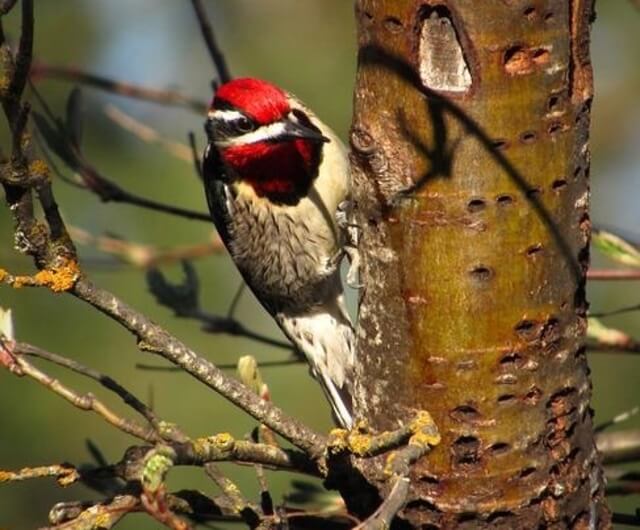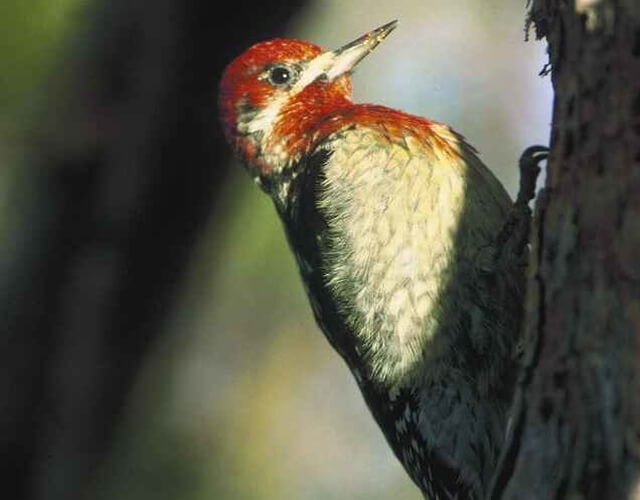
The sapsucker woodpecker is a bird that can be found in North America. It is typically found on the edge of forests, wetlands, and open areas. The sapsucker woodpecker gets its name from its diet, which consists mainly of sap or tree bark which has been tapped for sap.
This article will provide some interesting sapsucker facts, such as: what it looks like, where it lives, what it eats, and how you can help to protect them!
Table of Contents
Interesting Sapsucker Facts
- The Sapsucker is a small, stout-bodied woodpecker with a relatively short bill.
- There are four species of Sapsuckers in North America. They are the Red-naped Sapsucker, Williamson’s Sapsucker, Red-bellied Sapsucker and the Yellow-bellied Sapsucker.
- The Sapsucker is a type of woodpecker that belongs to the family “Picidae.”
- These sapsuckers live mostly in the northern parts of Canada, Alaska, Maine, Minnesota, Montana, New York and Washington state.
- All four species have similar habitats which include forests with plenty of trees for roosting or nesting as well as lots of insects to eat.
- All members of this family are characterized by their zygodactyl toes (two toes facing forward and two back) which allow them to climb trees head first.
- Sapsuckers have pointed bills for drilling into trees to feed on sap and insects that live inside trees.
- This bird primarily eats tree sap, insects and other invertebrates, but it will also eat fruit and berries when they are available.
- They live in deciduous forests or coniferous forests, and often make their homes near streams or rivers, where they have access to food year round.
- The male and female have similar plumage, but the males are typically more brightly colored than females.
- The name “sapsucker” comes from their feeding habits of drilling holes in trees to extract sap (or “sap”). It has been hypothesized that this habit may have contributed to their evolution into a primarily insectivorous diet.
- Sapsucker Woodpeckers are found in North America and prefer to live in areas where there is a variety of different trees to choose from, including both hardwoods and softwoods.
- These birds tend to nest in the hollows of dead or dying trees, which are typically filled with sap and other fluids from previous years’ drilling.
- Sapsucker facts show that sap-eaters have a number of different predators, including hawks, eagles, raccoons, cats, coyotes, owls, foxes, owls, eagles, snakes, and raccoons.
- Most of the sapsucker’s life expectancy is about 5 years.
- Sapsuckers are considered “not vulnerable” to extinction in parts of their range.
- These factors include, among others, weather, the number of natural resources that the area provides, and other predators of sapsuckers. They have been increasing in population.
Sapsucker Species in North America
Yellow-bellied Sapsucker

- Length: 7.1-8.7 in (18-22 cm)
- Weight: 1.5-1.9 oz. (43-55 g)
- Wingspan: 13.4-15.8 in (34-40 cm)
- Scientific Name: Sphyrapicus varius
The yellow-bellied sapsucker is a widespread bird that can be found in most of the United States. The bird breeds in the eastern half of the country, with scattered populations also found in the west. The sapsucker’s distribution range includes a wide variety of habitats including deciduous and coniferous forests, suburban gardens and even urban parks.
The diet consists mainly of tree sap and insects, but they will also eat arthropods, fruits, berries and nuts. The sapsucker nests in holes in trees, cliffs or buildings.
Red-naped Sapsucker

- Length: 7.1-8.7″ in (18-22 cm)
- Weight: 1.1-2.3 oz. (32-65 g)
- Wingspan: 15.7-17.3″ in (40-44 cm)
- Scientific Name: Sphyrapicus ruber
The Red-naped Sapsucker is a common bird in the eastern United States, but its distribution range extends south to Florida and west to Oklahoma. This sap-sucking bird prefers habitats with plenty of deciduous trees, such as forests and orchards.
They primarily feed on tree sap and insects, especially aphids and scale insects, in the tree canopy or on the ground, and they occasionally eat berries and fruit. The Red-naped Sapsucker nests in holes in trees, but has also been known to use abandoned woodpecker cavities.
Red-breasted Sapsucker

The Red-breasted Sapsucker woodpecker is a small bird that resides in the Northern Hemisphere. It can be found throughout Canada and all the United States except for parts of California, Nevada, Oregon, Arizona, New Mexico and Texas.
It eats mainly tree sap and insects like ants or beetles, but also consume berries and fruit. The bird’s common name derives from the fact that it feeds on sap, which it extracts by drilling holes in trees or other plant stems with its strong, chisel-like bill.
- Length: 7.9-8.7″ in. (20-22 cm)
- Weight: 1.9-2.2 oz. (53.0-63.5 g)
- Wingspan: 14.2-16.0″ in. (36-40.5 cm)
- Scientific Name: Sphyrapicus varius
Williamson’s Sapsucker

- Length: 7.9-10.2″ in (20-26 cm)
- Weight: 1.5-2.0 oz (43-56 g)
- Wingspan: 16.5-17.0″ in (42-43.2 cm)
- Scientific Name: Sphyrapicus thyroideus
The Williamson’s Sapsucker ranges from the coastal areas of North Carolina south to Florida, west to Texas and Oklahoma, and east as far as eastern Tennessee. It inhabits a variety of habitats including deciduous, mixed forest and pine-oak forests.
The diet consists mainly of insects, although it will also eat berries, nuts and seeds. It nests in holes in trees or other elevated sites.
How to Attract Sapsucker’s to your yard?
If you’re like most backyard bird enthusiasts, you’ve probably been looking for ways to attract sapsuckers to your yard. After all, these birds are among the most colorful and interesting in the bird world! Here are a few ways to attract them.
- Choose a sapsucker-friendly tree or shrub. Maple, birch, elm, pine, and aspen are all good choices for this purpose. These trees and shrubs produce large quantities of tree sap that sapsuckers love.
- Put up a suet feeder with peanut butter suet or berry suet. This will give the sapsuckers a place to sit and feed. The best way to attract them to your yard is with a suet feeder. The one I prefer to use is the Bird’s Choice SNDTP Bird 2-Cake Feeder with Angled Suet Basket, you can check out the price on Amazon.
- Provide a bird bath, and make sure there is plenty of fresh, clean water available daily.
Frequently Asked Questions
Do Sapsuckers eat bugs?
Sapsuckers, like other woodpeckers, drills holes into trees to get at insects living inside the bark or deep within branches of the tree. They will then drill many more tiny holes to drink up the sap as it flows out.
Do Sapsuckers harm trees?
Sapsuckers feed on insects that it finds in trees, and drills holes into the bark of tree trunks to extract sap for food. These birds do not usually harm trees or cause significant damage, but sometimes they may drill too many holes, which weakens the tree’s structure.
Where do Sapsuckers nest?
They are only found in North America and live in forests with large trees. These birds nest high up in the canopy, often as high as 100 feet off of the ground! Their nests are made out of mosses, grasses, leaves and bark strips which they find at their nesting site.
Can a Sapsucker kill a tree?
The short answer is no, it can’t. Sapsucker’s main source of food are the tree’s wounds and dead parts. For a Sapsucker to kill a tree it would need to spend months of its life pecking away at the bark until it eventually compromised the survival of the tree.
Is Sapsucker a Woodpecker?
Woodpeckers and sapsuckers both belong to the same order of birds called Piciformes, which includes about 160 species worldwide. The Sapsucker is a member of the genus “Sphyrapicus,” while the Woodpecker belongs to the genus “Melanerpes.”



